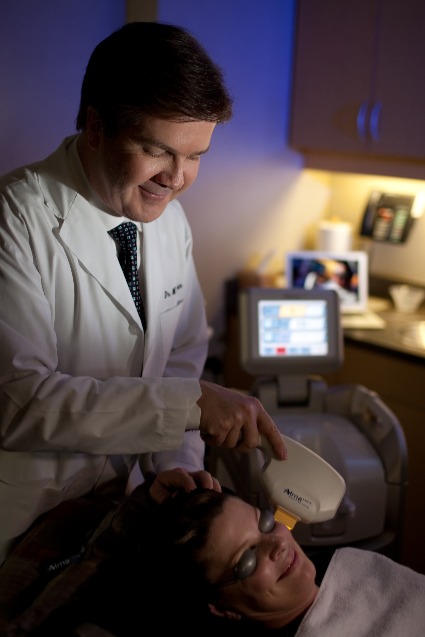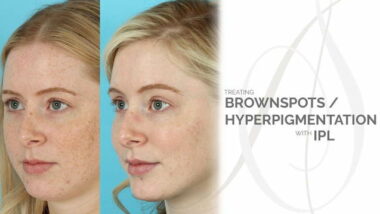IPL Treatments for Face (Intense Pulsed Light) photofacial is a treatment for skin pigment concerns: sun spots, brown age spots, rosacea and acne.
On This Page
- What to know about intense pulsed light treatment
- How does IPL work?
- What Is Intense Pulsed Light (IPL) Treatment?
- The difference between IPL and laser treatment
- Why Try an IPL Treatment to Get Rid of Sun Spots
- What Does IPL Stand For & What Does It Do?
- What Do IPL Procedures Do For Your Skin?
- What Does The IPL Treatment Look and Feel Like?
- How Long Does it Take To Heal After IPL?
- How Much Do IPL Treatments Cost?
- How To Get The Best Results From An IPL Treatment
- IPL vs. Laser Treatments: Knowing the Difference
- IPL Photofacial: What Is It?
- What Is an IPL Photofacial?
What to know about intense pulsed light treatment
We live in a world that is ever-evolving in its technology with new advancements, improvements, and upgrades. Today we are discussing the latest technology in skincare – the intense pulsed light (IPL) treatment technique.

Let’s compare two techniques commonly used to remove age spots: Microneedling vs. IPL (Intense Pulsed Light). Each type of treatment has benefits for specific skin conditions. Intense pulsed light (IPL) is a laser treatment that targets dark spots on the skin.
Intense pulsed light (IPL) therapy is a way to improve the color and texture of your skin without surgery. It can undo some of the visible damage caused by sun exposure called photoaging.
How does IPL work?
IPL, which was originally developed and used for dermatology treatment of rosacea and telangiectasia, has now proven to be very effective in MGD treatment. IPL works by focusing a strategic level of light pulses (500–800nm wavelengths) to penetrate the skin under the eye and targets the root cause of the malfunctioning meibomian gland.
You can use IPL anywhere on your body, but it may not work as well on uneven areas.
What Is Intense Pulsed Light (IPL) Treatment?
Bringing new hope to sufferers of dry eye syndrome as well as people with brown and spotted skin, IPL treatment (intense pulsed light) is now available at many optometrists. Dry eye syndrome is an irritating condition, ranging from general eye discomfort to severe inflammation of the upper eyelid.
Once you have received you will most likely join the growing band of people who have become infinitely better about remembering to wear sunscreen every day. IPL treatment (which stands for intense pulsed light) that helps reverse the signs of sun damage on a cosmetic level but does nothing to prevent it coming back if you continue to sunbathe without using high sun factor lotions to protect your skin.
An IPL (intense pulsed light) photo facial is a laser treatment that addresses common skin pigment concerns including sun spots, age spots, freckles, and other blemishes. Using laser light energy, an IPL photo facial can heat deep layers of skin, causing collagen and blood vessels to constrict, resulting in reduced redness while removing the outer layer of skin to reduce brown spots.
The difference between IPL and laser treatment
When used as hair-removal methods, both lasers and intense pulsed light (IPL), use light to heat hair follicles and prevent regrowth. While similar sounding, the technology used by each really isn’t, with the key difference being the light source used.
As it is a laser treatment, however, it carries the same potential side effects as IPL. Microdermabrasion is another option for people who want to rejuvenate the appearance of their skin.
We believe that laser hair and IPL treatments are the way forward in body hair treatment, we pride ourselves in working with salons that focus on providing relaxing and stimulating environments for IPL and laser hair removal and providing them the best machines on the market.
Why Try an IPL Treatment to Get Rid of My Sun Spots
IPL is FDA approved for the treatment of rosacea and has been used for many years to treat hair removal and sunspots. What are IPL treatments like?
IPL for sun damage. IPL is a powerful treatment for sun damage, including the reduction of brown pigment spots caused by sun exposure over the years, and fading broken veins and red blood vessels.
IPL stands for intense pulsed light, meaning the treatment uses a variety of wavelengths of light instead of a laser. I have had many friends recommend IPL to me after having various skin issues treated, mostly to get rid of unwanted freckles and sunspots. See our before and after images giving examples of results achieved from IPL treatments.
What Does IPL Stand For & What Does It Do?
It combines cutting-edge technology with attentive care: your comfort, safety, and satisfaction will be treated as absolute priorities. Patients who choose IPL can rest assured that their treatment will be performed with the highest standard of care.
IPL can be combined with facial injections that can be used for dynamic rhytids. Home IPL devices have been developed. BBL (broadband light), developed by us-based Sciton. The device uses an advanced version of the IPL technology in light therapy that is noted to have set a higher standard for treating skin conditions associated with aging, pigmentation irregularities, and the removal of hair follicles.
IPL technology is always improving and now there is also VPL technology, which stands for variable pulsed light. Like IPL, this uses a broad spectrum of light rather than lasers. But is used for hair removal. The settings can be changed so that different types of hair can be targeted, and in some cases, it may be suitable for lighter hair and more skin types.
What Do IPL Procedures Do For Your Skin?
IPL is one of the most popular cosmetic procedures for treating facial skin conditions, but new applications of the technology are emerging in optometry.
The limelight IPL treatment may be performed alone or combined with other non-invasive procedures for optimum skin rejuvenating results. Especially beneficial are the titan skin tightening and laser genesis procedures, which together are known as 3d rejuvenation.
The cost of IPL treatments is often less than that of laser treatments as well. Another benefit of IPL photorejuvenation procedure is that it allows for additional treatment with chemical peels, microdermabrasion, and other facial skin treatments that target the outermost layer of skin, the epidermis.
What Does the IPL Treatment Look and Feel Like?
You are permitted to clean your skin once or twice a day with lukewarm or tepid water and a gentle cleanser. If this is your first IPL treatment, your skin may feel a bit sensitive, especially outdoors.
After a treatment, there is often mild scabbing in some of the treated areas. Many patients say it feels a bit like a sunburn afterward. One of the benefits of IPL is that there is very little to no downtime.
Immediately following your IPL photo facial treatment, it is common to feel like you have mild sunburn. This typically resolves within 24 to 48 hours. Redness and/or swelling may accompany this and usually resolves in 4-8 days. Only after 1 month will the final result be seen.
How Long Does It Take to Heal After IPL?
Recovery from IPL photo facial is rapid and it is important to remember to use a broad-spectrum sunscreen such as a broad-spectrum sunscreen, to ensure the procedure lasts as long as possible.
The immediate result comes with the decrease in discoloration, but the long term (“maintenance”) result from getting IPL regularly is that it really helps to:
- keep the skin looking younger and healthy,
- help promote collagen growth,
- prevent effects of sun damage, and
- give the skin that healthy glow.
Light photo-rejuvenation using IPL is a non-invasive treatment that treats skin damage without disruption of the skin’s surface, meaning no downtime.
How Much Do IPL Treatments Cost?
Although IPL skin rejuvenation has been proven effective, it does require between 2–5 treatments to provide the best results. Each treatment costs about $300–$600, depending on the intensity and scope of the treatment.
Physicians generally recommend that patients undergo multiple IPL sessions to achieve the best results, which means that treatments can sometimes be grouped together into a package deal at a lower cost.
On average, IPL costs up to $600 per treatment however professionals offer this for just $300 per treatment of the ocular area and/or $400 per full face treatment! It is recommended that patients receive 4 treatments, 3-4 weeks apart for optimum results.
How To Get The Best Results From An IPL Treatment?
Lumenis invented IPL and continues to perfect it, so some people say that Lumenis being the original, is the best. The Lumenis one is said to optimize power, pulsing, and light delivery to provide maximum results coupled with comfort and safety.
Acne patients shouldn't expect instant results from IPL acne treatment; the AAD reports that at least three treatments generally are needed before the patient begins to see significant improvement.
Given the variety of laser treatments and the choice of IPL, it is important to consider the benefits of each and which applies best to the results you are looking to achieve.
IPL vs. Laser Treatments: Knowing the Difference
We point this out so that consumers may understand the differential in power between q-switched lasers and IPL treatments. This differential in power is the difference between getting IPL treatments every three to six months for brown spots and getting permanent removal of these same spots after 3 q-switched treatments.
About IPL treatments. Intense pulsed light, or IPL, is often considered a laser treatment, but there is a difference. Unlike a traditional laser resurfacing treatment, IPL devices emit broad-spectrum light.
These two treatments are similar, but there are some distinct differences. A laser will emit light on a specific wavelength towards your skin. IPL will release light from many different wavelengths, like a flash from a camera.
IPL Photofacial: What Is It?
Intense pulsed light (IPL) and broadband light (BBL) technology use powerful, pulsed light to achieve skin improvement in a procedure commonly known as phototherapy. The procedure is sometimes called a photofacial, though it can be used on any area of the body.
IPL = intense pulsed light also referred to as “photofacial”.
IPL is a technology used by cosmetic and medical practitioners to perform skin treatments for aesthetic and therapeutic purposes.
What Is an IPL Photofacial?
Rejuvenate your skin and reduce the signs of sun damage with intense pulsed light (IPL) photofacial. This exciting technology uses a broad spectrum of light to target broken capillaries, redness, rosacea, sun spots, age spots, and fine wrinkles.
Therefore, more repeat visits may be required to produce the desired results. Another consideration that may or may not affect one’s decision to undergo a photofacial is the dearth of research studying the long-term impact of IPL treatments, which is to be expected with a technology that’s younger than lasers, only in use since 1995.
IPL stands for intense pulsed light. In some contexts, it can be called photofacial, but in terms of IPL treatment for rosacea, it is a form of photorejuvenation.




